'Kashmir Defends Democracy'
The
pamphlet cover displayed above is from a title published in 1948 by the
Kashmir Bureau of Information in Delhi. The design is arresting, and
clearly leftist in inspiration. The designer (the name is in the bottom
left hand corner) was Sobha Singh, at the time a young progressive
artist. In later years, he became better known for his religious
paintings of the Sikh Gurus.
The woman in the foreground depicted lying on the ground and aiming a rifle is Zuni Gujjari, a woman from a milkman's family who became renowned as a militant supporter of the National Conference, the main Kashmiri nationalist party. The black and white photograph is of members of the Women's Self Defence Corps, a women's militia set uplargely by Communist supporters of the National Conference in October-November 1947, when Srinagar was in danger of being overrun by an army of Pakistani tribesmen. Altogether, a very remarkable image - and one which made me think more deeply about the political and social alignments in the Valley as the Kashmir conflict first erupted.
Krishna Misri (nee Zadoo), a veteran of the women's militia, has helped me identify some of those featured in the photograph. She is towards the back, third from left. Much more prominent at the head of that file, wearing what looks to be a light coloured smock, is her younger sister, Indu. Two further right, looking down, is Usha Kashyap - better known now as Usha Khanna and the founder of the renowned Samovar restaurant at the Jehangir art gallery in Mumbai. In front of her is a shorter woman, also looking down, wearing a narrow white headscarf. She's Begum Zainab, one of the leaders of the militia. To her right, more prominent and with a white scarf around her neck, is Jai Kishori Bhan.
Neerja Mattoo has also helped to identify several of the women featured, including her sisters.
The woman in the foreground depicted lying on the ground and aiming a rifle is Zuni Gujjari, a woman from a milkman's family who became renowned as a militant supporter of the National Conference, the main Kashmiri nationalist party. The black and white photograph is of members of the Women's Self Defence Corps, a women's militia set uplargely by Communist supporters of the National Conference in October-November 1947, when Srinagar was in danger of being overrun by an army of Pakistani tribesmen. Altogether, a very remarkable image - and one which made me think more deeply about the political and social alignments in the Valley as the Kashmir conflict first erupted.
Krishna Misri (nee Zadoo), a veteran of the women's militia, has helped me identify some of those featured in the photograph. She is towards the back, third from left. Much more prominent at the head of that file, wearing what looks to be a light coloured smock, is her younger sister, Indu. Two further right, looking down, is Usha Kashyap - better known now as Usha Khanna and the founder of the renowned Samovar restaurant at the Jehangir art gallery in Mumbai. In front of her is a shorter woman, also looking down, wearing a narrow white headscarf. She's Begum Zainab, one of the leaders of the militia. To her right, more prominent and with a white scarf around her neck, is Jai Kishori Bhan.
Neerja Mattoo has also helped to identify several of the women featured, including her sisters.
1 Usha Kak nee Dhar
2 Kaushalya Kaul nee Dhar
3 Krishna Misri nee Zadoo
4
5
6
7
8
9
10 Shanta Kashkari (also identified as Janaki Devi)
11 Leela Bhan nee Dhar
12 Jai Kishori Dhar
13 Indu Pandit nee Zadoo
14 Khurshid Bakshi nee Jalauddin
15 Usha Khanna nee Kashyap
16 Zainab Begum
17
18
19 Jai Kishori Vashnavi nee Bhan
20
21 Laxmi Rambal
It's
wonderful that so many decades after this photograph was taken, it is
possible to retrieve the names and the stories of many of those
featured.
For an article about the People's Militia in Kashmir in 1947-48 and its political context, follow this link.
More photographs from this pamphlet have been posted further down the page.
Do you have any images to post on this site - or any comments or memories to share? If so, please do get in contact with me.
For an article about the People's Militia in Kashmir in 1947-48 and its political context, follow this link.
More photographs from this pamphlet have been posted further down the page.
Do you have any images to post on this site - or any comments or memories to share? If so, please do get in contact with me.
Zuni Gujjari with Akbar Jehan (oh, and Edwina Mountbatten)
I
have Nyla Ali Khan to thank for this tremendous photo of Zuni (or Zoon)
Gujjari - on the left - with Edwina Mountbatten and Akbar Jehan, the
wife of Sheikh Abdullah. It appears in Nyla's biography of Akbar Jehan,
her grandmother, entitled The Life of a Kashmir Woman. She believes it was taken in 1947 when Edwina Mountbatten was active in Red Cross work.
The Women's Self Defence Corps
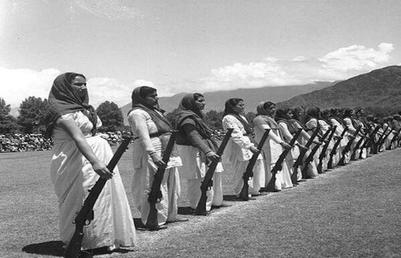
Here's
another wonderful photo of the women's militia - probably from late
1947 or early 1948. It was tweeted by 'indianhistorypics' and I am
trying to found out about the photographer, and to see if any of the
women can be identified. if you can help, please get in touch.
It does look as if it was taken at the same occasion - see below - when Nehru inspected the women's militia. And perhaps by the same photographer.
It does look as if it was taken at the same occasion - see below - when Nehru inspected the women's militia. And perhaps by the same photographer.
The invading lashkar
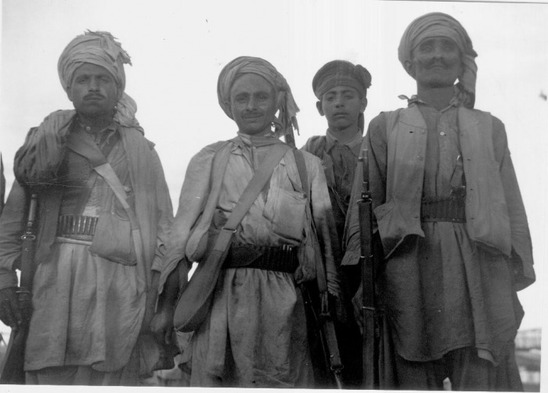
These
are the men whose invasion of Kashmir prompted the women above to take
up arms. They are members of the 'lashkar', the raiding party of tribal
fighters from Pakistan which crossed into Kashmir from October 22nd
1947.
This remarkable photograph is of Orakzai tribesmen on their way to fight in Kashmir. It was taken in Rawalpindi on 13th November 1947.
The photographer was Frank Leeson, who had been serving with the khassadars in Waziristan, the scouts who were being trained to work alongside the local establishment. He took a huge number of photographs, which he labelled with great care. Many were used in his book Frontier Legion, eventually published in 2003.
Frank gave me permission to use this image in my book A Mission in Kashmir, and indeed it is such a striking image it features on the cover.
This remarkable photograph is of Orakzai tribesmen on their way to fight in Kashmir. It was taken in Rawalpindi on 13th November 1947.
The photographer was Frank Leeson, who had been serving with the khassadars in Waziristan, the scouts who were being trained to work alongside the local establishment. He took a huge number of photographs, which he labelled with great care. Many were used in his book Frontier Legion, eventually published in 2003.
Frank gave me permission to use this image in my book A Mission in Kashmir, and indeed it is such a striking image it features on the cover.
And the Indian soldiers they were fighting
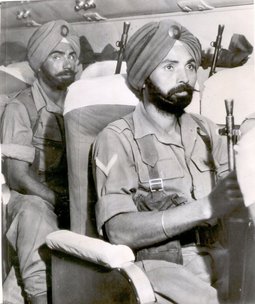
Here's a photo of the Indian soldiers who were airlifted to defend Kashmir from the tribal army. These Sikh soldiers were not the first to make their way to the princely state. The Indian airlift into the Kashmir Valley began at first light on 27th October 1947. Those soldiers were from the 1st Battalion, The Sikh Regiment. Their commanding officer, Lt Colonel Dewan Ranjit Rai, was killed by armed tribesmen the following day on the outskirts of Srinagar.
This photo dates from a couple of weeks later. I bought it on ebay - part of a photo news agency archive being sold piece by piece. Dakota transport planes were brought in for the initial stages of the airlift. Later commercial passenger planes such as this were requisitioned. It looks much to plush for troop transport. Perhaps that's why the soldiers look a little startled. They were however flying to Jammu, quite a distance from any of the fighting, rather than to the airstrip outside Srinagar.
... or to be precise Patiala State troops
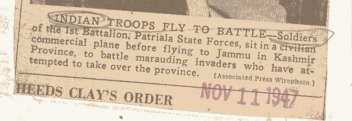
This
is the news cutting on the back of the photo above. The soldiers were
part of the Patiala state forces - so had a loyalty to one of the
princely states which had just become part of independent India. There's
quite a controversy about whether Patiala troops were in Kashmir before
the airlift started - and if so whether they were a small contingent
aiding Kashmir's maharajah, or a fighting force involved in repulsing
the raiders.
Nehru inspecting the Women's Militia at Srinagar
A
compelling photograph (above) of Jawharlal Nehru inspecting the
Kashmir women's militia - the women's self-defence corps - in Srinagar. I
am not sure of the date - almost certainly the end of 1947 or early in
1948. Begum Zainab, the leader of the militia, is escorting Nehru. In
the background is a Srinagar landmark the Takht-e-Suleiman or
Shankacharya Hill. Krishna Misri tells me that the woman one from the
far left, with the patterned top, is Sajda Begum. Neerja Mattoo adds
that on the far left is her sister, Usha Kak.
The women's militia drilled and was trained in how to fire a rifle and throw a grenade. Its main intention was to allow young women to protect themselves and their households should Srinagar be overrun. The tribal army got to the outskirts of the city but not further. The women's militia did not see active service, though many of its members were involved in relief work for the refugees resulting from the invasion.
This photograph was taken by the master photographer Ram Chand Mehta. His business, Mahatta, is still going on the Bund at Srinagar - when I was last there I popped in to say hello to the current proprietor, Ram Chand Mehta's son. I am posting this photo with the permission of Hemant Mehta, Ram Chand Mehta's grandson. The rights rest with Hemant's picture agency, India Picture.
The women's militia drilled and was trained in how to fire a rifle and throw a grenade. Its main intention was to allow young women to protect themselves and their households should Srinagar be overrun. The tribal army got to the outskirts of the city but not further. The women's militia did not see active service, though many of its members were involved in relief work for the refugees resulting from the invasion.
This photograph was taken by the master photographer Ram Chand Mehta. His business, Mahatta, is still going on the Bund at Srinagar - when I was last there I popped in to say hello to the current proprietor, Ram Chand Mehta's son. I am posting this photo with the permission of Hemant Mehta, Ram Chand Mehta's grandson. The rights rest with Hemant's picture agency, India Picture.
The Children's Militia at Srinagar's Lal Chowk
Another
photograph by Ram Chand Mehta taken in Srinagar in 1947-48. These are
youngsters drilling with wooden rifles in Lal Chowk in the centre of the
city. In the excited political atmosphere of late October and November
1947, when the maharajah had fled and Sheikh Abdullah came to power and
straight away faced an invasion of Pathan tribesmen, thousands of people
of Srinagar took up arms in some fashion or another. Several members of
the men's militia were killed in service - including Pushkar Zardoo,
the brother of Krishna Misri.
The photograph was taken outside the Palladium Cinema, which the National Conference took over as their headquarters. The building still stands, just, but is a ruin - bearing witness to the agony Kashmir has endured over the last twenty years in particular.
Again, I am very grateful to Ram Chand Mehta and India Picture for allowing me to post this photo.
The photograph was taken outside the Palladium Cinema, which the National Conference took over as their headquarters. The building still stands, just, but is a ruin - bearing witness to the agony Kashmir has endured over the last twenty years in particular.
Again, I am very grateful to Ram Chand Mehta and India Picture for allowing me to post this photo.
The Women's Militia at Srinagar airfield
Another
wonderfully evocative photo taken by Ram Chand Mehta - Begum Zainab and
the women's militia, and beyond them the men, at the airstrip at
Srinagar. I imagine they were there to meet Nehru. I haven't yet managed
to identify any of the women ... help welcome! India Picture hold the
rights to this image.
Krishna Misri has managed to identify some of the women - here's an extract from the email she sent me (April 2015). "Yes, this is a picture taken at the airport to welcome Nehru. I can place just a few faces. Starting from the right, Sajjida Zameer Ahmad and Kamla Shankar, my elder sister. The third and fourth I cannot recognise. The fifth is Begum Jallaludin, Mahmuda Ahmad Ali's elder sister. She taught in a government girl's school in later life and rose to the position of Director, Women's School Education dept.. Leading the contingent is, of course, Zainab Begum." Krishna also subsequently identified the last woman in the row as Freda Bedi. Neerja Mattoo (December 2015) has identified the third from right as her sister, Usha Kak.
Krishna Misri has managed to identify some of the women - here's an extract from the email she sent me (April 2015). "Yes, this is a picture taken at the airport to welcome Nehru. I can place just a few faces. Starting from the right, Sajjida Zameer Ahmad and Kamla Shankar, my elder sister. The third and fourth I cannot recognise. The fifth is Begum Jallaludin, Mahmuda Ahmad Ali's elder sister. She taught in a government girl's school in later life and rose to the position of Director, Women's School Education dept.. Leading the contingent is, of course, Zainab Begum." Krishna also subsequently identified the last woman in the row as Freda Bedi. Neerja Mattoo (December 2015) has identified the third from right as her sister, Usha Kak.
The People's Militia
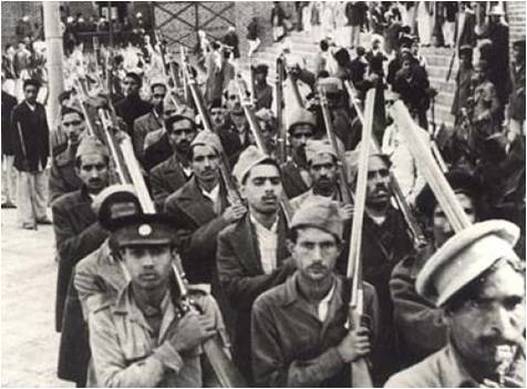
A wonderful photo, which appeared in 'Outlook' to accompany Omar Abdullah's review of my book. It's captioned: Circa
'47: Peace brigades marching towards the Secretariat on the eve of
Sheikh Abdullah's taking over of the Emergency administration. I hadn't seen it before, and the magazine doesn't make clear the provenance.
If the caption is accurate, this dates from early November 1947. The National Conference militia has clearly been armed - by the Indian army - but the rather haphazard drill suggests that training hasn't got very far.
he image underlines the ad hoc nature of the militia. And although it was raised to defend the status quo - to keep Pakistani irregulars out of Srinagar and to defend Kashmir's accession to India - it was also a revolutionary force. After almost four centuries of what those in the Kashmir Valley would regard as outside rule, a Kashmiri Muslim with popular support had just taken the helm in the Valley - and these men were willing to fight to keep it that way.
If the caption is accurate, this dates from early November 1947. The National Conference militia has clearly been armed - by the Indian army - but the rather haphazard drill suggests that training hasn't got very far.
he image underlines the ad hoc nature of the militia. And although it was raised to defend the status quo - to keep Pakistani irregulars out of Srinagar and to defend Kashmir's accession to India - it was also a revolutionary force. After almost four centuries of what those in the Kashmir Valley would regard as outside rule, a Kashmiri Muslim with popular support had just taken the helm in the Valley - and these men were willing to fight to keep it that way.
Sheikh Abdullah in 1947
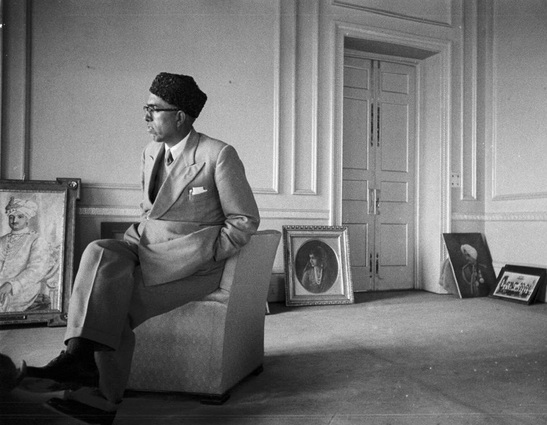
This wonderful brooding photograph of Sheikh Abdullah was posted on Twitpics by Omar Abdullah - click here or on the image. It's labelled simply: 'Another one of my grandfather from 1947 or there about.'
It strikes me that this photograph is more than that. Taken, I would surmise, in a royal palace. And that portrait on the left looks to be of Yuvraj Karan Singh. Does anyone know more? If so, please email to <awkashmir@gmail.com>
This is posted here in accordance with Twitpics community guidelines.
On the story behind the photograph, Shabbir Hyder says: "There is no detail about the photographer. But it seems to have been clicked in 1947 when Sheikh Mohd Abdullah was appointed Emergency Administrator of J&K. The place seems to be Old Secretariat in Srinagar."
It strikes me that this photograph is more than that. Taken, I would surmise, in a royal palace. And that portrait on the left looks to be of Yuvraj Karan Singh. Does anyone know more? If so, please email to <awkashmir@gmail.com>
This is posted here in accordance with Twitpics community guidelines.
On the story behind the photograph, Shabbir Hyder says: "There is no detail about the photographer. But it seems to have been clicked in 1947 when Sheikh Mohd Abdullah was appointed Emergency Administrator of J&K. The place seems to be Old Secretariat in Srinagar."
Abeer
who works at the Amar Mahal Museum and Library in Jammu has been in
touch (June 2014) - he's convinced that the portrait on the left is not
Karan Singh, but has identified the two others. The portrait of a woman
is of Maharani Tara Devi, Karan Singh's mother, And propped up in the
corner is either a portrait or photograph of Raja Amar Singh, Maharajah
Hari Singh's father (and so Karan Singh's grandfather). He believes the
venue is Gulab Bhavan / Grand Palace, which is now a hotel. He
estimates the date as 1948. But the photographer - well, it's clearly a
composed portrait shot by an accomplished photographer, but who?
UPDATE April 2018: with the help of Jehangir Bakshi, we can now reveal who took this photo and when - it was the work of Howard Sochurek, a photographer with the news magazine Life, taken in November 1951. There are more details here.
UPDATE April 2018: with the help of Jehangir Bakshi, we can now reveal who took this photo and when - it was the work of Howard Sochurek, a photographer with the news magazine Life, taken in November 1951. There are more details here.
'New Kashmir'
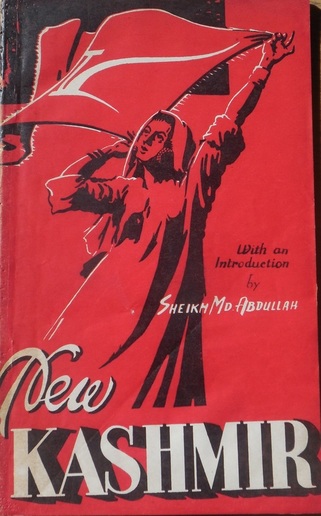
This is the cover to the English edition of 'New Kashmir', the decidedly leftist manifesto adopted by Sheikh Abdullah's National Conference in 1944. The woman reminds me of Marianne, the iconic emblem of the French Revolution. The flag she is holding is that of the National Conference, depicting a white plough on a red background.
The contents of the document were - according to one well-informed veteran of Kashmiri politics I spoke to - largely translated from a Soviet Central Asian publication. The only section which had to be written afresh, he told me, was Sheikh Abdullah's introduction. In this, Abdullah declared that 'Soviet Russia has demonstrated before our eyes, not merely theoretically but in her actual day to day life and development, that real freedom takes birth only from economc emancipation'.
The manifesto set out proposals which it described as 'in worthy participation of the historic resurgence of the peoples of the East, and the working masses of the world, and in determination to make this our country a dazzling gem upon the snow bosom of Asia.'
Hardly surprising, then, that one of Sheikh Abdullah's first acts on gaining power was to rename Srinagar's main square as Lal Chowk, meaning Red Square. That's still its name.
Kashmir at war - November 1947
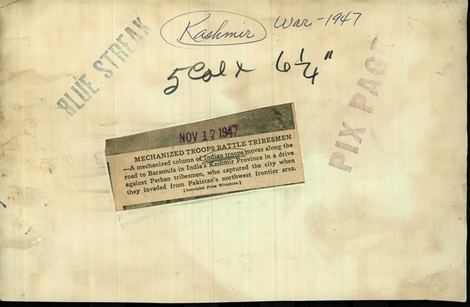
Many
thanks to Jagan Pillarisetti, who sent me these two marvellous news
photos from Kashmir in November 1947 and gave me permission to post them
here. The caption on the rear of the photo above reads:
'MECHANIZED TROOPS BATTLE TRIBESMEN. - A mechanized column of Indian troops moves along the road to Baramula in India's Kashmir Province in a drive against Pathan tribesmen, who captured the city when they invaded from Pakistan's northwest frontier area.'
It's date stamped 17 November 1947, but was probably taken a week or two earlier.
'MECHANIZED TROOPS BATTLE TRIBESMEN. - A mechanized column of Indian troops moves along the road to Baramula in India's Kashmir Province in a drive against Pathan tribesmen, who captured the city when they invaded from Pakistan's northwest frontier area.'
It's date stamped 17 November 1947, but was probably taken a week or two earlier.
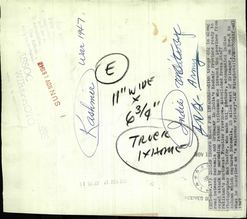
The caption:
'INDIAN TROOPS READY FOR INVADERS - Sikh troops dig in along road from
Baramula to Srinagar in India's Kashmir Province ready to repel attack
by marauding Pathan tribesmen who invaded the province from Pakistan's
Northwest Frontier Province. Associated Press Staff Photographer Max
Desfor, who made this picture, accompanied Indian column which captured
Baramula, 25 miles west of Srinagar, on Nov. 6 in what he described as
"a walkover victory".'
The date stamp is 18 November 1947 - I suspect it was taken quite a bit earlier. Max Desfor, a Pulitzer-winner, celebrated his 100th birthday in 2013!
The date stamp is 18 November 1947 - I suspect it was taken quite a bit earlier. Max Desfor, a Pulitzer-winner, celebrated his 100th birthday in 2013!
St Joseph's, Baramulla - take 1
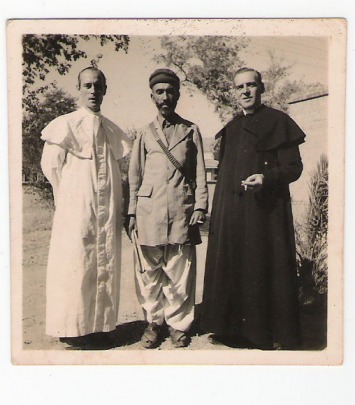
A photo with quite a story attached. The two priests are Father George Shanks (right) and Gerry Mallett - the two Mill Hill missionaries based at St Joseph's college, Baramulla, in 1947. With them is a man dressed in Pathan style and bearing an ammunition belt. He seems to be holding a paper, and he and Father Shanks are smoking.
I believe this was taken in October - November 1947 when the convent and mission hospital at St Joseph's was ransacked by the tribal lashkar. Six people were killed in the attack. Among the dead was Jose Barretto whose wife Greta Barretto was the hospital doctor. This photo is in the possession of their daughter, Mrs Angela Aranha. The priests and about seventy others were held captive by the tribesmen for about eleven days - holed up in a ward of the mission hospital. The full story is told in A Mission in Kashmir, and it also formed the basis of H.E. Bates's novel The Scarlet Sword.
St Joseph's, Baramulla - take 2
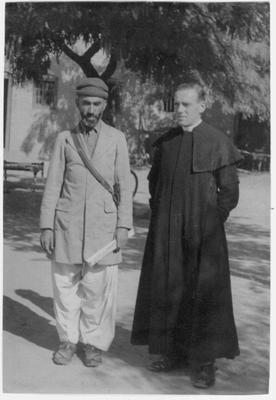
It seems that this photograph was taken within minutes of the one above. There's no Father Mallett - but Father Shanks is in the same clerical garb, and the Pathan man is still clutching the same paper. Both look a little more anxious. It's not a very comfortable or composed shot. I was given this photograph by Mrs Maureen Corboy, the last surviving sister of Father Shanks. Another of his sisters had written on the back: 'G. Making friends with the man who intended shooting him.' In another hand is the date: 1946. It's impossible to be certain, but I believe it's more likely that the photo was taken the following year.
The Pathan may well have been Syed Sarwar Shah, described by George Shanks is his manuscript account of the ordeal at Baramulla - held in the Mill Hill Missionaries' archive - as 'a friendly Mahsud'. Shanks wrote: 'I shall always have a warm spot in my heart for Sarwar Shah, in spite of his casually mentioning afterwards that he had been all in favour of shooting us all at first'.
A letter from Baramulla
A
remarkable letter written in Baramulla by Father Shanks to his sister
Vernonica. It's dated September 20th [1947], just over a month before
the tribal army raided St Joseph's. I was given this letter by another
of Father Shanks's sisters, Maureen Corboy:
'Whether this will ever reach you is problematic these days - Pakistan and India are too busy knocking one another's heads off to bother about postal services at the moment. My home mail came fairly regularly until about a week ago, but nothing since then. And mail from outside Kashmir seems to have stopped completely. The denizens of Pakistan are sitting down in armed mobs on the Rawalpindi road + stopping all supplies from entering Kashmir - nobody but a Mohameddan or a European can travel these days. Meanwhile, our Maharajah still goes on sitting on the fence, so we are peaceful enough up to now, but there is a certain amount of tension in the air, + we may have a spot of bother at any moment. However, if it comes, it will be purely a domestic row between the two parties, and there is no danger for us. So if you do see Kashmir mentioned in the news, there will be no cause for alarm.
'Meanwhile, there does not seem to be any possibility of hearing anything definite about my passage until things settle down. The same with my passport - I have tried the government of the W. Punjab without result, and have now tried to get at the British High Commissioner in Karachi by airmail, but so far he does not seem to be interested. There is no British representative in Kashmir at present, so it looks as if I shall have to be a stowaway. ...
'The nuns here have presented me with a nice new overcoat, + those in Srinagar with a black suit, so I am ready for the road at any time now. Let's hope I don't get stuck up in Kashmir while a passage is waiting for me.'
'Whether this will ever reach you is problematic these days - Pakistan and India are too busy knocking one another's heads off to bother about postal services at the moment. My home mail came fairly regularly until about a week ago, but nothing since then. And mail from outside Kashmir seems to have stopped completely. The denizens of Pakistan are sitting down in armed mobs on the Rawalpindi road + stopping all supplies from entering Kashmir - nobody but a Mohameddan or a European can travel these days. Meanwhile, our Maharajah still goes on sitting on the fence, so we are peaceful enough up to now, but there is a certain amount of tension in the air, + we may have a spot of bother at any moment. However, if it comes, it will be purely a domestic row between the two parties, and there is no danger for us. So if you do see Kashmir mentioned in the news, there will be no cause for alarm.
'Meanwhile, there does not seem to be any possibility of hearing anything definite about my passage until things settle down. The same with my passport - I have tried the government of the W. Punjab without result, and have now tried to get at the British High Commissioner in Karachi by airmail, but so far he does not seem to be interested. There is no British representative in Kashmir at present, so it looks as if I shall have to be a stowaway. ...
'The nuns here have presented me with a nice new overcoat, + those in Srinagar with a black suit, so I am ready for the road at any time now. Let's hope I don't get stuck up in Kashmir while a passage is waiting for me.'
A Baramulla wedding
A
wonderful photo of a Christian wedding in Baramulla in, probably, 1946 -
including Father Shanks who features in the photos above. It appears to
have been taken in the ground of the Chinar hotel. Many of those shown
were caught up in the events of the following year. I've asked three
different people to help identify those shown - they don't always agree,
and I have left spellings uncorrected below:
BACK (L to R) C.R. J.C. R.R.
1 Walter Tresslor Walter Trusseller
2 Reggie Presrecha
3 Okelly’s son-in-law
4 Leonard Rath Dr Francis Rath
5 Mrs Mary Dhar
6 Mrs Avis Tresslor Mrs Avis Trusseller
7
8
9 Eric Pasricha Prem Pasricha
MIDDLE
1 Mrs Okeley Okelly’s dau
2 Mr Okeley Mr Presrecha
3 Pamila Pasricha Leela Lila (of Chinar hotel)
4 – bridegroom Mr Gerald Gerald De’silva
5 – bride Mrs Sheila Sheila De’silva
6 Mrs Wilifrida Vinfred De’silva
7 Fr Shanks Fr Shanks Father Shanks
8 Mrs Rath Mrs Grace Rath
9 Mrs Pasricha
10 Mr Pasricha Anthony De’silva
FRONT, KNEELING
1 Ranjit Dhar
2
3 Kamal Dhar
4
5
6 Dolly Rath Dorothy Rath
7 Phillis Rath Phyllis Rath
Date: 1946
Venue: Chinar Hotel
Owned by Okeleys
BACK (L to R) C.R. J.C. R.R.
1 Walter Tresslor Walter Trusseller
2 Reggie Presrecha
3 Okelly’s son-in-law
4 Leonard Rath Dr Francis Rath
5 Mrs Mary Dhar
6 Mrs Avis Tresslor Mrs Avis Trusseller
7
8
9 Eric Pasricha Prem Pasricha
MIDDLE
1 Mrs Okeley Okelly’s dau
2 Mr Okeley Mr Presrecha
3 Pamila Pasricha Leela Lila (of Chinar hotel)
4 – bridegroom Mr Gerald Gerald De’silva
5 – bride Mrs Sheila Sheila De’silva
6 Mrs Wilifrida Vinfred De’silva
7 Fr Shanks Fr Shanks Father Shanks
8 Mrs Rath Mrs Grace Rath
9 Mrs Pasricha
10 Mr Pasricha Anthony De’silva
FRONT, KNEELING
1 Ranjit Dhar
2
3 Kamal Dhar
4
5
6 Dolly Rath Dorothy Rath
7 Phillis Rath Phyllis Rath
Date: 1946
Venue: Chinar Hotel
Owned by Okeleys
In May 2018, I received a very welcome email from Karan Dhar who is related to several of those in the weddinng photo. He said:
'We were extremely happy to find my father Ranjeet Dhar, Grandmother Mrs.Mary Dhar, Uncle Kanwal Dhar (mentioned as Kamal Dhar) and Uncle Rattan Dhar’s photo (Rattan Dhar is the one sitting between Ranjeet Dhar and Kanwal Dhar, he was the youngest amongst the 3 brothers, my dad being the eldest, then my uncle Kanwal and then Rattan), unfortunately all of them are no longer with us. ... My grandmother Mrs.Mary Dhar was Christian and belonged to Rath family, she was married to my grandfather Mr.Prithvi Nath Dhar (Kashmiri Pandit) from Raj Bagh, Srinagar.'
'We were extremely happy to find my father Ranjeet Dhar, Grandmother Mrs.Mary Dhar, Uncle Kanwal Dhar (mentioned as Kamal Dhar) and Uncle Rattan Dhar’s photo (Rattan Dhar is the one sitting between Ranjeet Dhar and Kanwal Dhar, he was the youngest amongst the 3 brothers, my dad being the eldest, then my uncle Kanwal and then Rattan), unfortunately all of them are no longer with us. ... My grandmother Mrs.Mary Dhar was Christian and belonged to Rath family, she was married to my grandfather Mr.Prithvi Nath Dhar (Kashmiri Pandit) from Raj Bagh, Srinagar.'
Freda Bedi
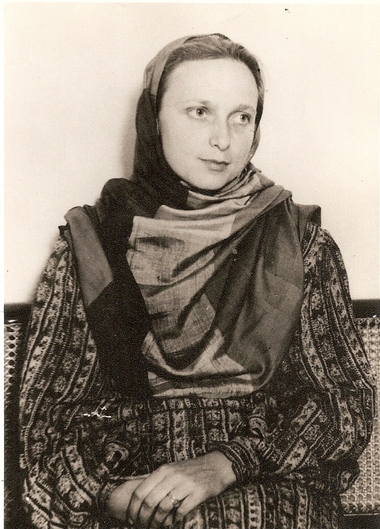
Copyright: Bedi family archives
Freda
Bedi - Freda Houlston, as she was known before her marriage - was from
Derbyshire. She studied at Oxford, married B.P.L. 'Baba' Bedi, and came
out to India where there were both immersed in nationalist and leftist
politics. 'Barely a week aftr finishing Final Schools', Freda wrote, '
we were married in the dark and poky little Oxford Registry Office.' She
wore a sari as her wedding dress, and in the autumn of 1934, the Bedis
and their four month old baby moved to India.
Both Freda and Baba Bedi were active in Kashmir in the 1940s, and wer close to Sheikh Abdullah and the National Conference. Freda famously wore a burqa and carried message around Kashmir and to and from Lahore in the mid-1940s when the maharaja jailed many Kashmiri nationalist leaders. This photograph was taken in Lahore in 1942 when Freda was an active Congress worker.
The photo is from Freda and Baba's elder son, Ranga Bedi, and is posted here with his permission. Ranga writes: 'My mother was a Congress woman in the 1940s, offered Satyagraha as one and served a six months jail term in Lahore Jail in 1941/42. I may be wrong but I think she was the first British woman to serve a jail term in the freedom movement. Her life was a fascinating story. A Masters from St. Hugh's in Oxford, took active part in India's freedom movement, and later in her life was Asia's highest ordained Buddhist Nun who championed the cause of Tibetan Buddhism worldwide.'
Both Freda and Baba Bedi were active in Kashmir in the 1940s, and wer close to Sheikh Abdullah and the National Conference. Freda famously wore a burqa and carried message around Kashmir and to and from Lahore in the mid-1940s when the maharaja jailed many Kashmiri nationalist leaders. This photograph was taken in Lahore in 1942 when Freda was an active Congress worker.
The photo is from Freda and Baba's elder son, Ranga Bedi, and is posted here with his permission. Ranga writes: 'My mother was a Congress woman in the 1940s, offered Satyagraha as one and served a six months jail term in Lahore Jail in 1941/42. I may be wrong but I think she was the first British woman to serve a jail term in the freedom movement. Her life was a fascinating story. A Masters from St. Hugh's in Oxford, took active part in India's freedom movement, and later in her life was Asia's highest ordained Buddhist Nun who championed the cause of Tibetan Buddhism worldwide.'
Freda and Baba Bedi
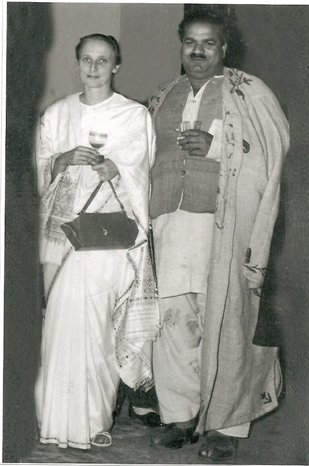
Copyright: Bedi family archive
This photo is also from Ranga Bedi - Freda and Baba Bedi together. Ranga tells me that it was taken at Nishat Bagh, one of the Mughal gardens in Srinagar, in 1948. The occasion was a garden party hosted by Sheikh Abdullah.
Baba Bedi was a prominent Punjabi communist and writer, remembered as very gregarious, and a key figure in Kashmiri politics in the 1940s. He is credited with being the main force behind the 'New Kashmir' manifesto of 1944, featured above. Margaret Bourke-White wrote about him - he accompanied her to Baramulla shortly after Indian troops repulsed armed tribesmen from the town.
The Bedis were a celebrated couple in Lahore and in Srinagar, with a wide circle of friends. While Freda turned to Buddhism later in life, Baba Bedi also embarked on a spiritual journey - in his case, Sikhism.
Their younger son is the film star Kabir Bedi. Of his mother, much noted for her looks and political courage, Kabir told me her renown was hardly surprising: 'she was blue eyed, white skinned and fighting the British'.
There are more photos of Freda and Baba Bedi and their children here.
Nedou's Hotel
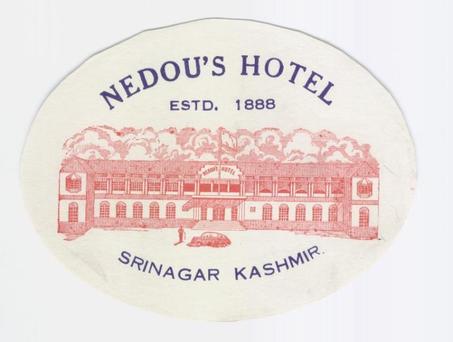
Nedou's
Hotel in Srinagar used to be the place to stay. The building is still
there on M.A. Road, close to the polo ground. You might be able to
recognise it from the drawing on this luggage label. But it's been used
for many years as a barracks for Indian security forces. Certainly, it
was already closed by the time I made my first visit to the Valley in
1993. I've never managed to get in to the grounds. The building doesn't
look to be too dilapidated - and it would be nice to think that one day
it will welcome guests once more.
The Nedou family was from Dubrovnik on the Croatian coast. They had hotels in Lahore and Gulmarg as well as Srinagar - the label below is from Nedou's heyday - and the Gulmarg establishment still thrives. Begum Abdullah, Sheikh Abdullah's wife, was a Nedou. Their hotel was absolutely the place to be during the last years of the Raj. It's where foreign correspondents stayed when they came up in October and November 1947 to cover the first shots in the Kashmir conflict.
Such is the anonymity that has descended on this once grand building that few in Srinagar are aware of its history - a sad reflection on how quickly the grass grows on a heritage that is untended. As of April 2014, there's some encouraging news about Nedou's, Srinagar - click here to find out more - and I've posted below a photo of how the hotel looks now.
The Nedou family was from Dubrovnik on the Croatian coast. They had hotels in Lahore and Gulmarg as well as Srinagar - the label below is from Nedou's heyday - and the Gulmarg establishment still thrives. Begum Abdullah, Sheikh Abdullah's wife, was a Nedou. Their hotel was absolutely the place to be during the last years of the Raj. It's where foreign correspondents stayed when they came up in October and November 1947 to cover the first shots in the Kashmir conflict.
Such is the anonymity that has descended on this once grand building that few in Srinagar are aware of its history - a sad reflection on how quickly the grass grows on a heritage that is untended. As of April 2014, there's some encouraging news about Nedou's, Srinagar - click here to find out more - and I've posted below a photo of how the hotel looks now.
More photographs from 'Kashmir Defends Democracy'
'Kashmir Speaks'
Kashmir Speaks
is the title of a book by Prithvi Nath Kaula and Kanahaya Lal Dhar, and
published in 1950. It had a foreword by Sheikh Abdullah, and the work's
sympathies lie with him, and with Kashmir's accession to India. It
includes several striking images, which I have scanned from a library
copy (so the quality is only passable) and I am posting here:
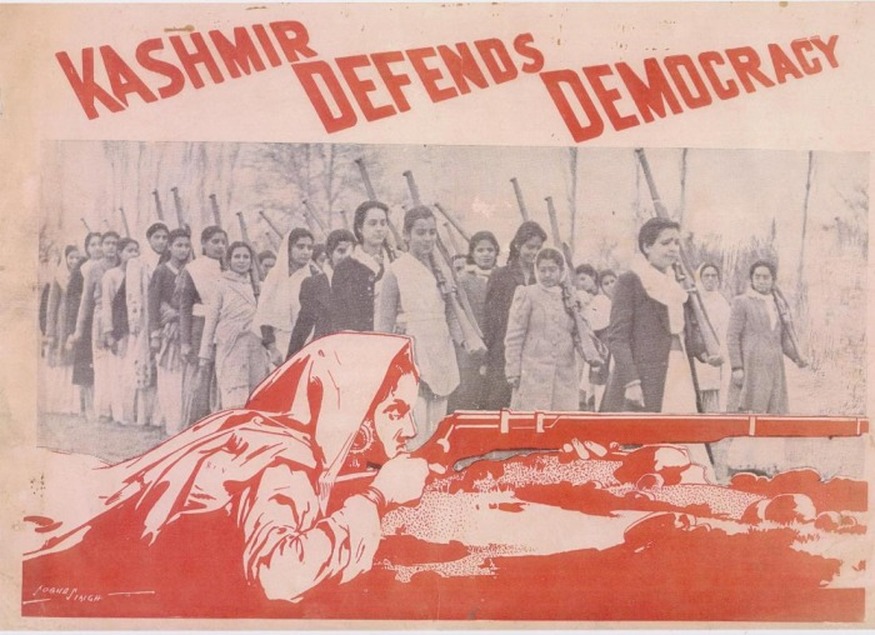
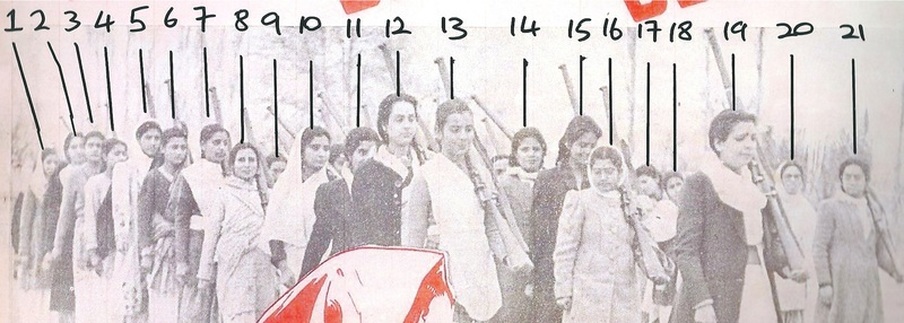
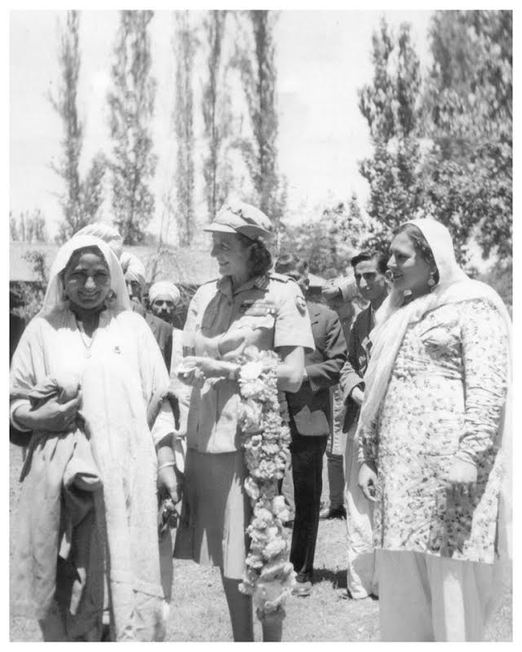
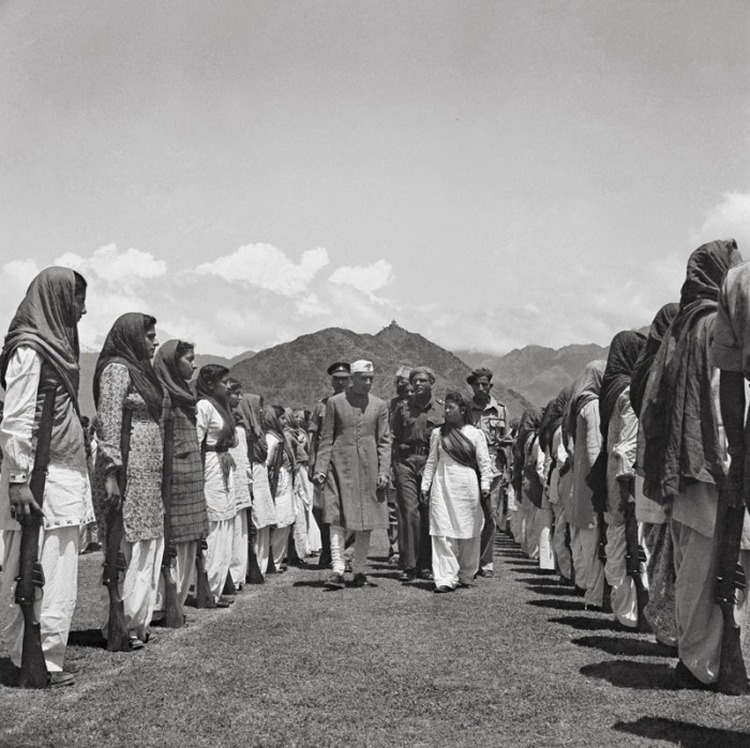
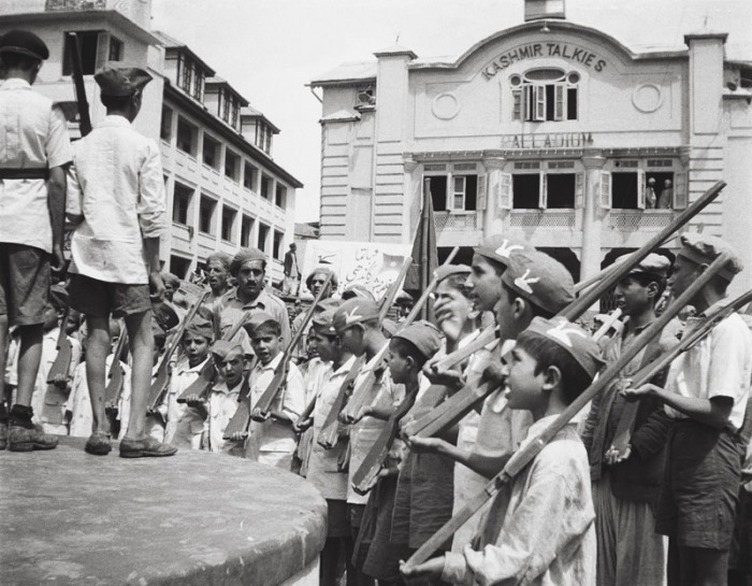
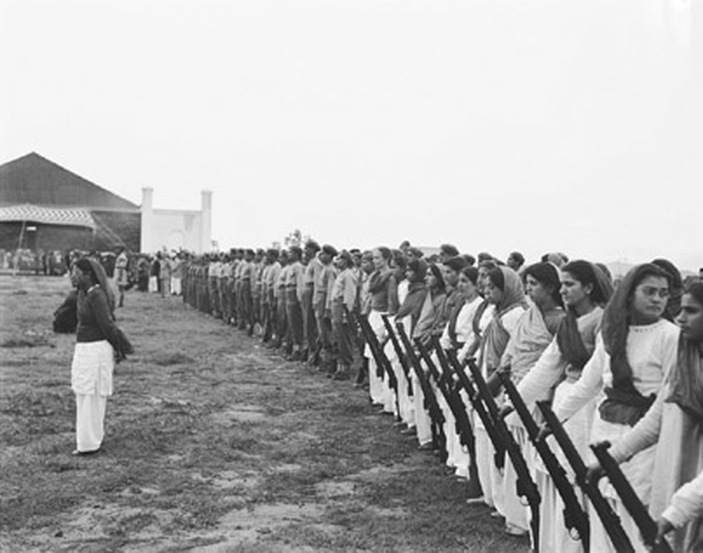
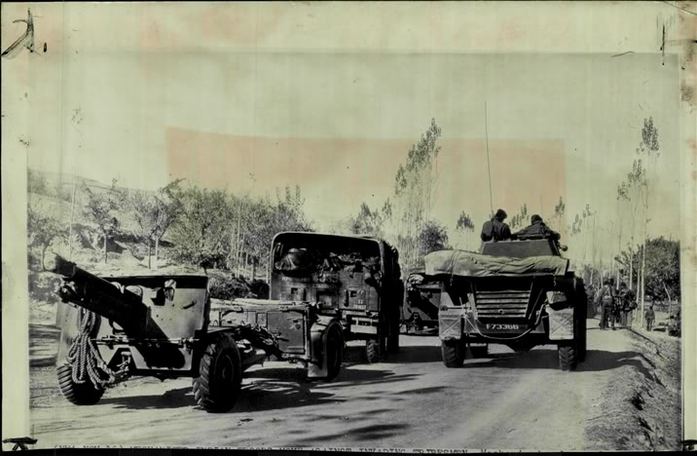
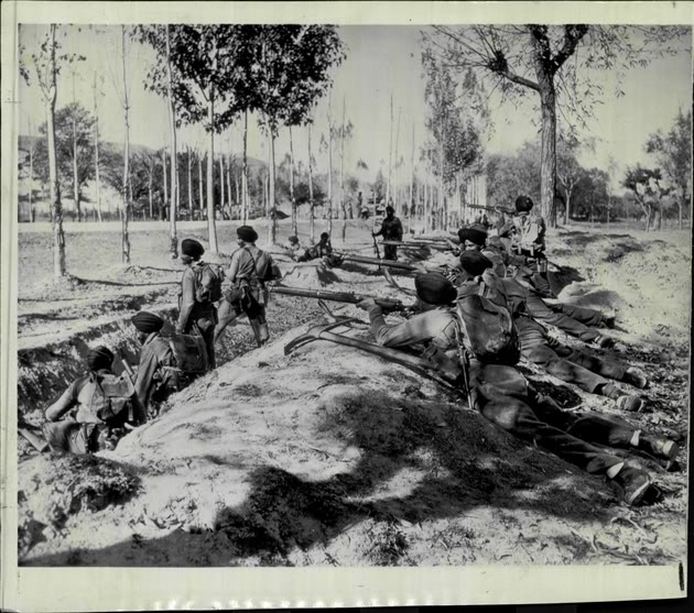
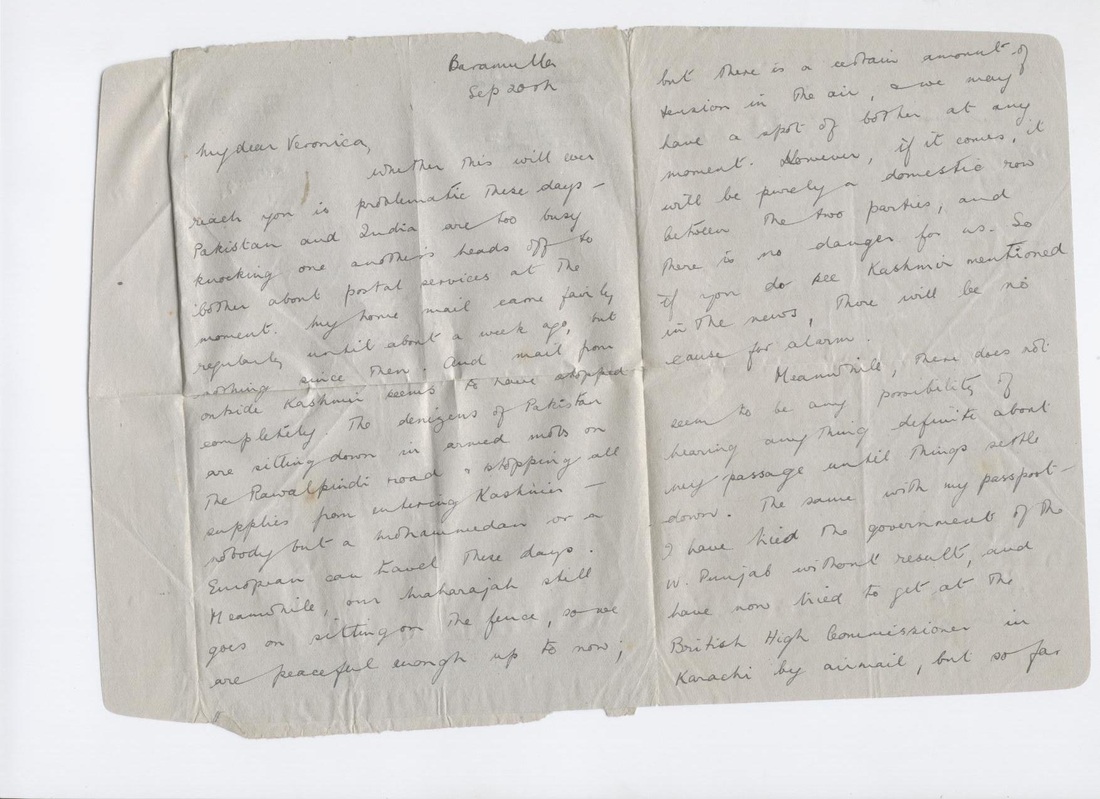
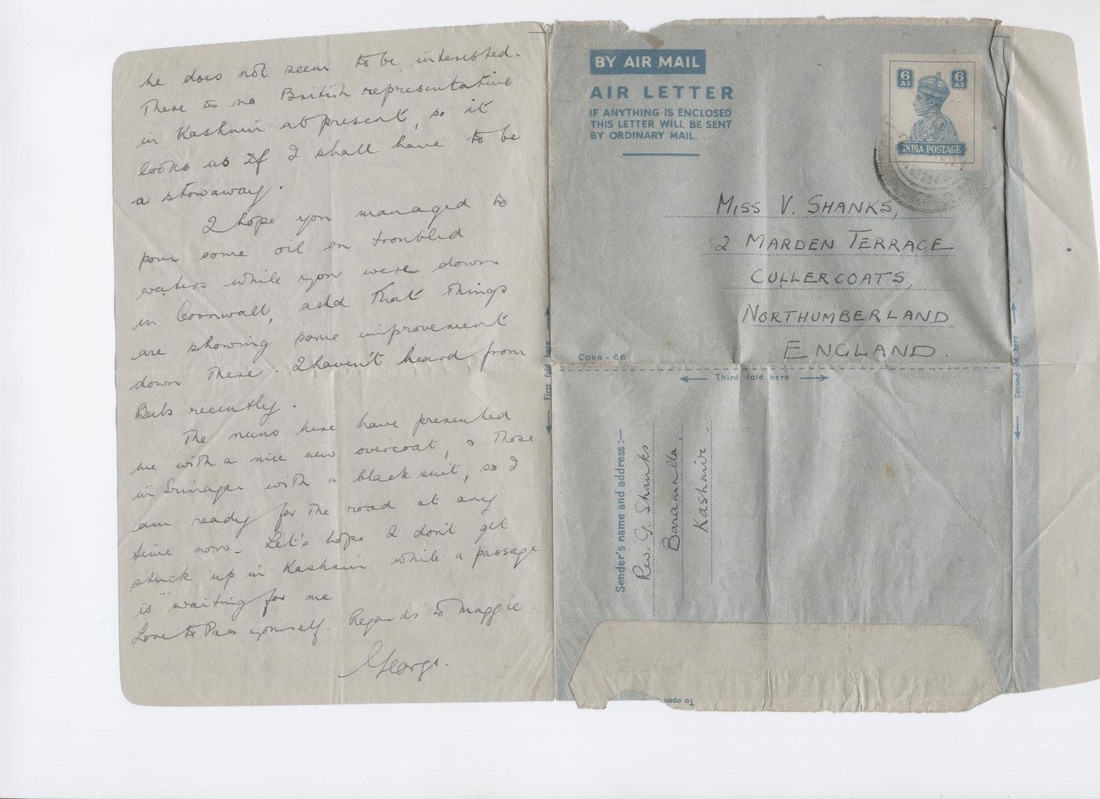
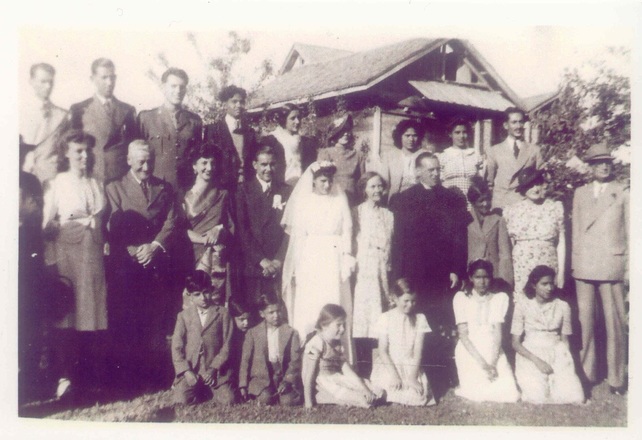
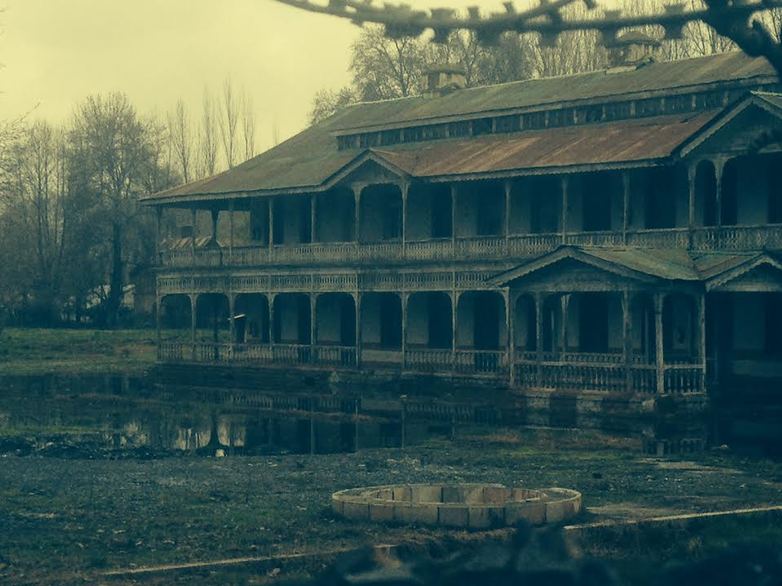
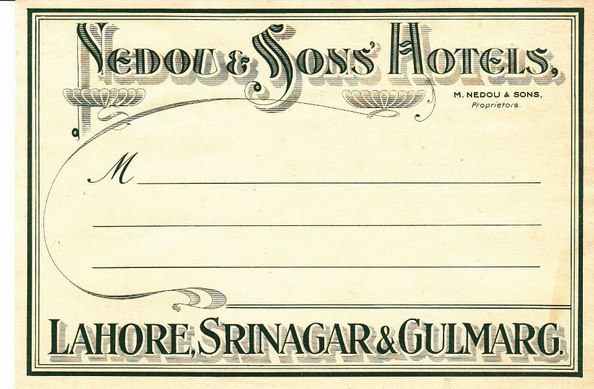
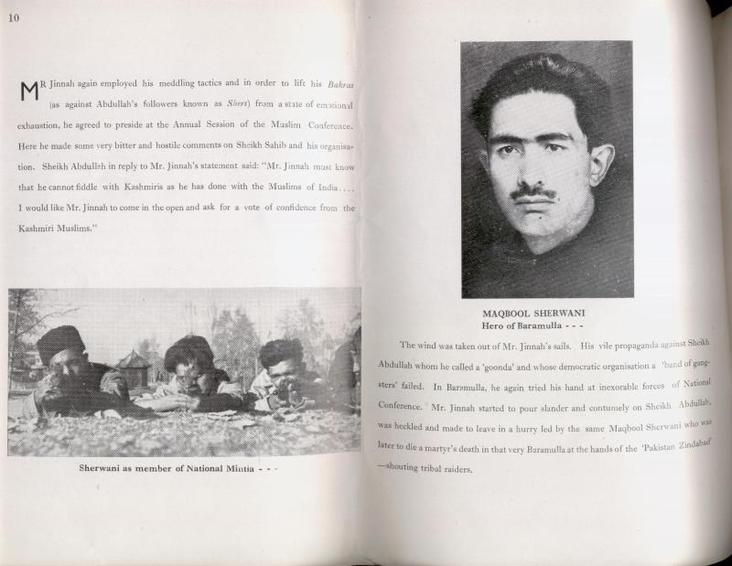
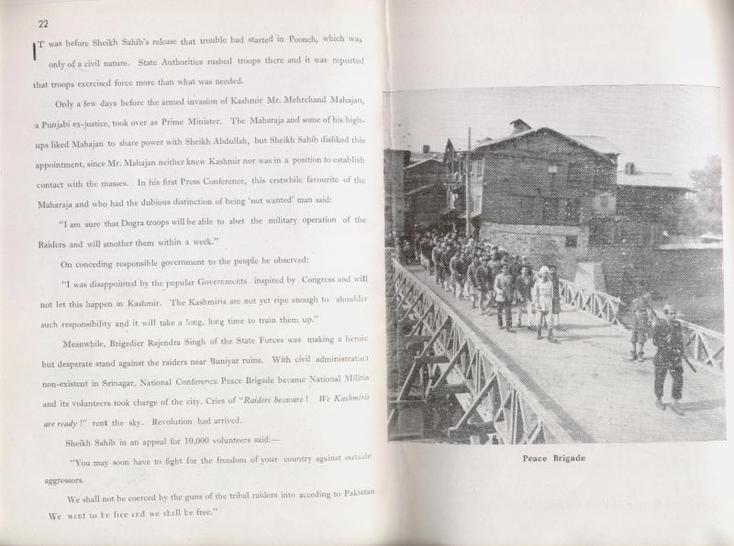
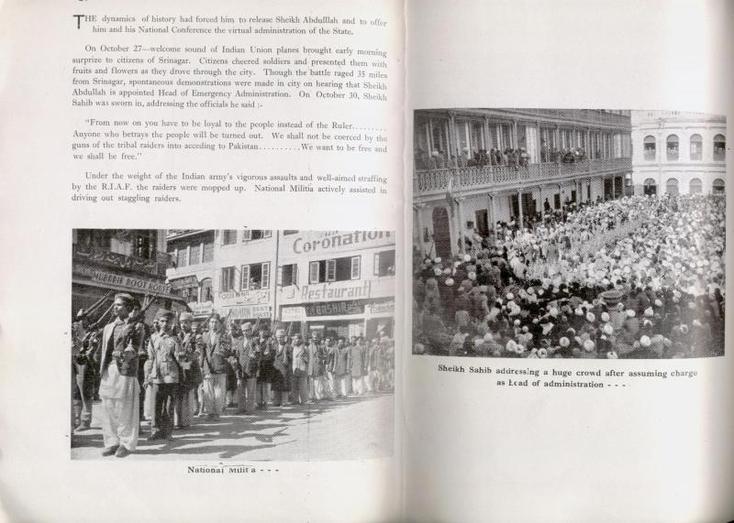
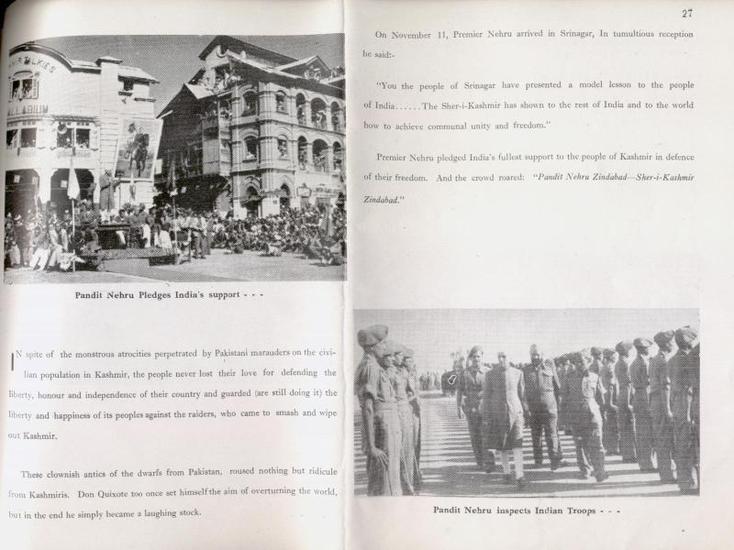
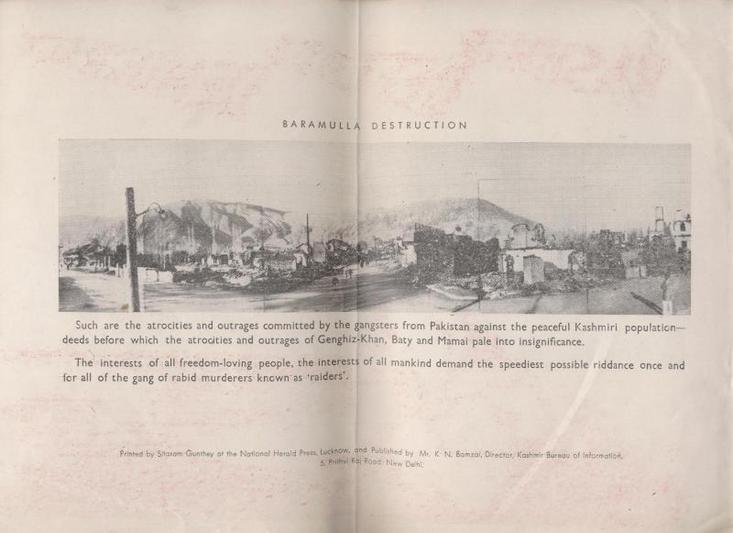
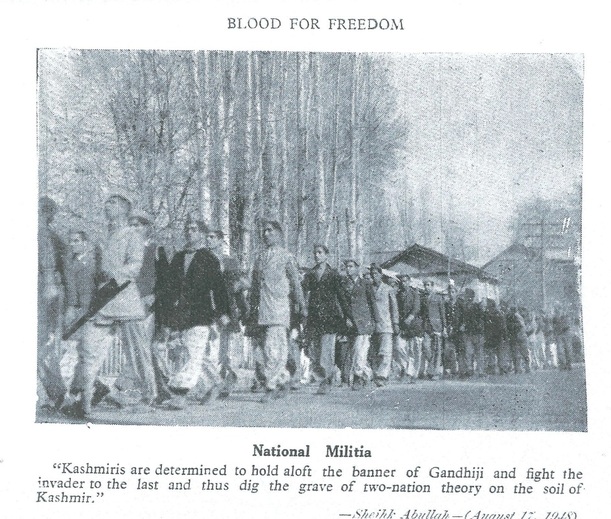
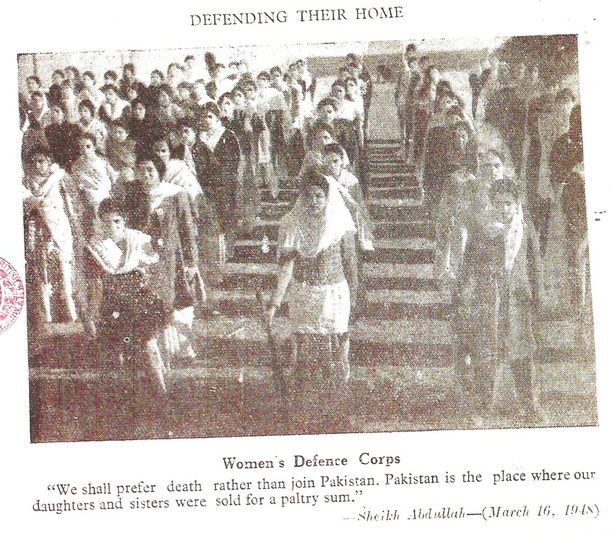
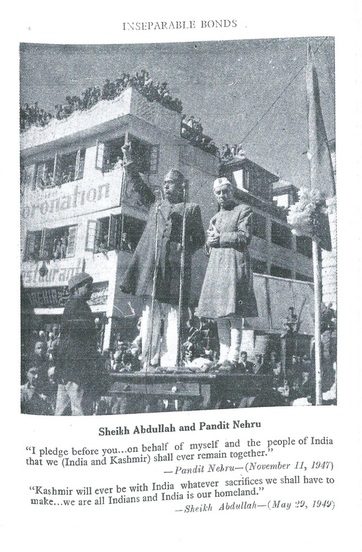
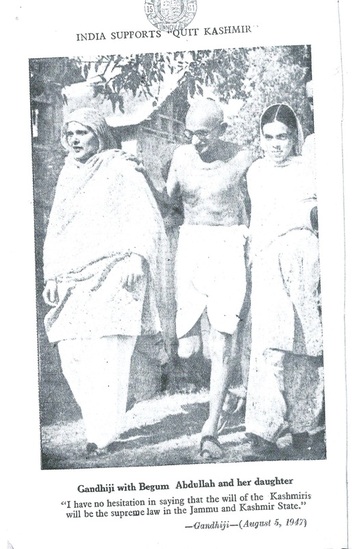
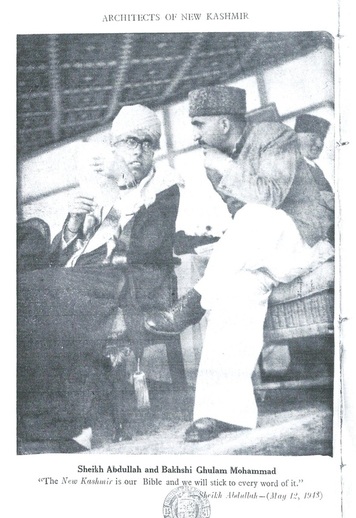
No comments:
Post a Comment